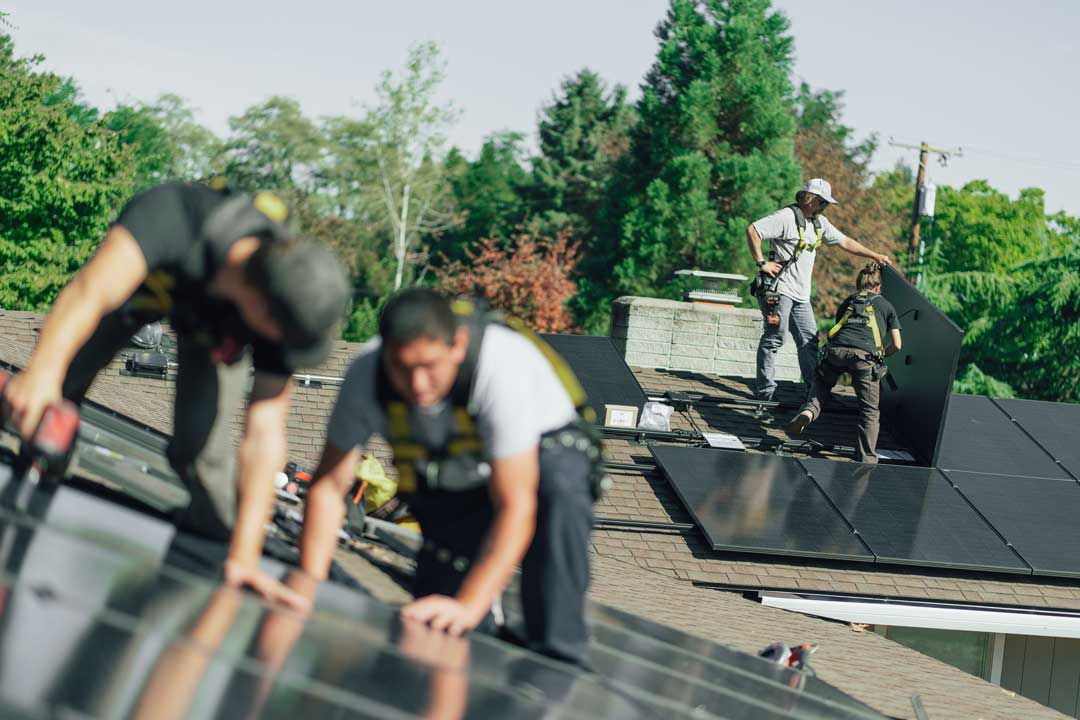Did you know that the average solar panel weighs about 40 pounds?
If you’re considering going solar at home, you’re most likely looking at installing solar panels on your roof. But will installing solar panels damage your roof?
The short answer is: solar should not damage your roof if it’s been properly installed.
But how do you know if solar has been properly installed, and what do you do if it isn’t? Keep reading as we go over 3 key things to know about rooftop solar.
The Basics of Solar Installed on a Roof
First, let’s go over some basics.
When you install rooftop solar, unless you’re installing something like solar tiles, your panels aren’t installed directly on your roof. Instead, racking from a reputable company like Unirac is installed.
Then your panels are attached to that racking.
Depending on the design of your system, a single rail of racking can hold multiple panels. Which means fewer points where the system is actually in contact with your roof.
If your solar was properly installed by a professional, then any points where the racking attaches to the roof would still be covered by roofing material to prevent leaks. It will also have enough clearance below to allow for airflow, and be installed on an angle (to help snow and such slide off).
Any solar installation company should also be willing to guarantee their workmanship for at least a handful of years. For instance, Purelight guarantees the workmanship on every installation we do for 10 years.
What Could Cause Damage to a Roof with Solar?
While solar shouldn’t cause damage to a roof, there are a few instances where you should proceed with caution.
First: Your Roof is Older or In Need of Repair.
As we mentioned above, solar panels are fairly heavy. A roof that has a structural issue or damage should ideally be repaired prior to having solar panels installed.
If you don’t make repairs, you risk the weight of your solar energy system contributing to further damage, plus the inevitable cost of having to have part or all of your system removed to make repairs to the roof later.
Second: Your Panels Were Installed Incorrectly.
When you go solar, you might be tempted to save some costs by installing your panels yourself.
But in order to install solar panels and a racking system properly, holes have to be drilled into your roof. That might sound like a recipe for disaster.
So long as you work with a professional company, they’ll make sure to use a combination of flashing material and sealant to create a water-tight seal wherever they drill.
Further, because of the distributed weight of both a single panel, and the system overall, improperly installed solar panels could cause structural damage overtime.
If you get solar panels installed by the cheapest option, rather than the most professional, you’re risking long term damage and costs for some short term savings.
It also could mean that your solar panels aren’t able to perform as efficiently as they should. Panels need to be installed at a specific angle, both to help capture as much UV light as possible, and to encourage snow and rain to slide off.
Third: Your Roofing Material Can’t Handle Solar
At Purelight, our goal is to help every homeowner we can to go solar simply and affordably. But in reality, not every homeowner can.
Certain types of roofing materials simply don’t work well with installing a racking system for solar.
Common material types including composite and asphalt shingles, metal roofing, and even some types of clay tiles can work with solar. But terracotta tiles, for instance, might mean that in order to install solar you have to remove sections of the roof.
That’s because the terracotta can’t withstand the drilling necessary to attach the racking for solar.
If you try to install solar on a roof with an incompatible material, there’s an increased likelihood of leaks, damage to the roofing material, and increased wear on the roof itself.
Why Install Solar On a Roof?
Now that you know some of the risks associated with installing solar on your roof, you might be asking if it’s worth it at all.
Despite needing to take certain precautions with rooftop solar, the benefits still outweigh those risks.
When solar is installed correctly by a professional solar installer, it can actually help your roof! How? By providing a barrier from the elements.
Roofs with solar installed see both longer lifespan of roofing material, and the home can see an added cooling effect.
Because solar panels create a barrier from the sun, which normally has a bleaching and drying effect that will eventually lead to brittle roofing material, they can help extend the lifespan of your roof by years. Not to mention protection from rain, hail, and snow.
Also cool (pun mostly unintended) is the way solar shades your roof, which has been shown in studies to help keep your whole home cooler.
Solar Perk #1: Saving Money Every Month
The biggest perk of all is wiping out your power bill and saving every month that you have solar. Homeowners who go solar regularly save $1,000 every year–and solar panels are designed to last at least 25 years.
Want to find out if your roof qualifies for $0 down solar from Purelight Power?
All it takes is a quick 60 second survey.





